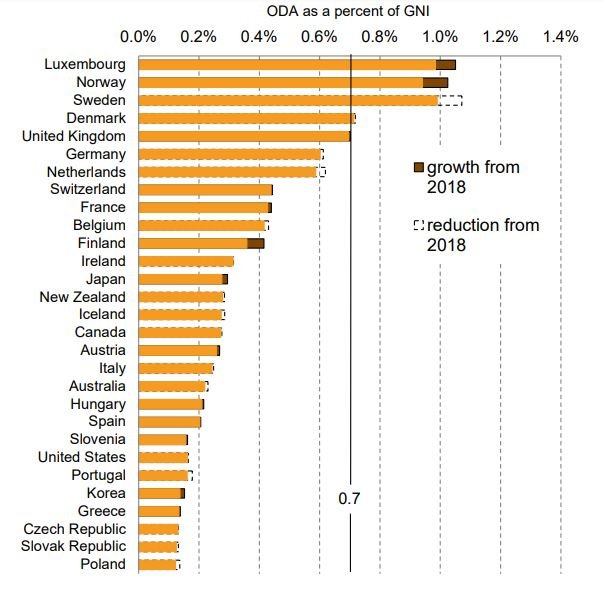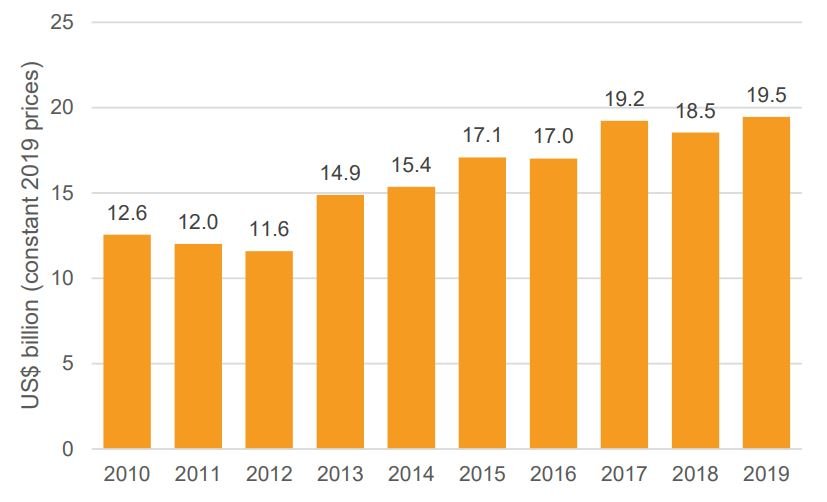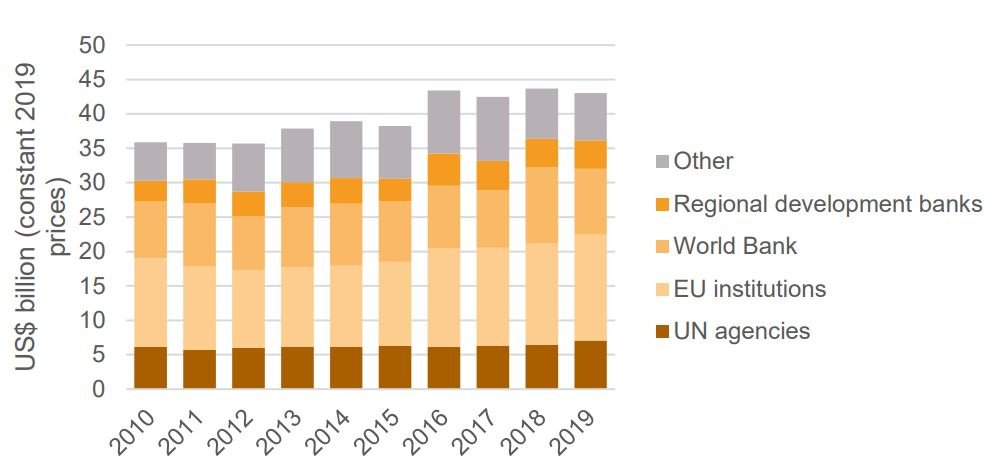Coronavirus and aid data: What the latest DAC data tells us
How might the coronavirus pandemic impact aid spending? DI presents analysis of preliminary ODA (aid) data for 2019. Our briefing shows how much was given and in what form.
DownloadsIntroduction
The world is facing an unprecedented challenge, with the vast impacts of coronavirus compounding worrying trends in aid. This briefing looks at the most recent trends in aid data (the OECD DAC’s release of provisional aid data for 2019) and considers what impacts the pandemic may have.
Even before the pandemic there were worrying trends in the economic outlook, both globally and for developing countries specifically. [1] For example, there were growing concerns of another debt crisis in developing countries, with 44% of low income countries (LICs) and least developed countries (LDCs) either at high risk of, or already in, debt distress. The global economic downturn and the immediate challenges of the health crisis both brought on by the coronavirus pandemic will, in many cases, exacerbate these concerns.
The impacts of the pandemic on global resource flows are already being felt. In March 2020 alone, investors pulled out approximately US$90 billion from emerging markets. [2] With other international flows such as remittances and receipts from tourism also set to fall, the counter-cyclical potential of aid (also known as official development assistance, or ODA) becomes increasingly important, not just in volume but also in the quality of that assistance and the use of appropriate tools and instruments for delivering it.
In addition to the immediate threat to lives and livelihoods (it is currently estimated that the crisis could push up to half a billion more people into poverty globally [3] and cause up to 3.3 million deaths in Africa alone [4] ), the coronavirus pandemic is likely to stall and indeed reverse progress towards achieving Agenda 2030. In this context, as developing countries face multiple and overlapping health, economic and social crises sparked by coronavirus, the unique potential of ODA to limit its impact on the poorest and most vulnerable people will be vital.
This briefing highlights both positive aid trends from 2019 – including slight upticks in global aid and aid to the poorest countries – but equally some more problematic trends that are likely to be exacerbated by the current crisis. The paper also projects the impacts of the crisis on the volume of ODA and considers the implications of other significant trends in considering the response to the crisis in developing countries.
Key points
1: ODA growth sees slight increases in 2019 amid concerns of a significant decline beginning in 2020.
► The crises in donor countries caused by the pandemic – from the immediate health crisis to the deep socioeconomic crises – are likely to drive reductions in global aid levels at a time when global aid flows have seen very limited growth since 2016.
2: The economic impact of coronavirus may lead to further substantial declines in ODA.
► A longer-term economic recession alongside cuts from donors as budget is reallocated to domestic spending could see global ODA levels drop sharply, with a fall of US$25 billion by 2021 within the range of possibilities.
3: The number of donors achieving the 0.7% ODA/GNI target remains the same, but there is potential for all donors, including those hitting this target, to see these ratios fall.
► The economic downturn and potential reallocation of current aid spending to domestic priorities could see significant falls in aid from some of the biggest donors – for example, up to US$8.2 billion from aid from the US.
4: ODA to the most vulnerable countries grows slightly, ahead of potential real-terms cuts.
► The poorest and most vulnerable countries will require more concessional grant finance to confront the challenges of the current crisis: domestic government expenditure on health in LDCs (PPP$29 per capita in 2017) is more than 100 times lower than in high income countries (PPP$3,692 in 2017).
5: Gross ODA lending by DAC donors up by 50% since 2010, despite warnings of a new debt crisis – and the growth has been fastest in lending to least developed countries.
► Countries already struggling to service debts will face additional constraints in responding to the long-term effects of the crisis.
6: Despite a rise in 2019, core contributions to the UN flatlined for most of the decade and lagged behind funding for loan-giving bodies.
► The World Health Organization (WHO), a key player in immediate and medium-term crisis response, has seen core funding fall by 13% between 2011 and 2018.
7: Following substantial growth in bilateral humanitarian assistance since 2012, such funding has fallen year on year since 2017 while needs have continued to rise.
► Without significant new funding, the repurposing of existing assistance in response to coronavirus risks exacerbating the existing humanitarian finance gap for other crises and contexts.
ODA growth sees slight increases in 2019 amid concerns of a significant decline beginning in 2020
Figure 1: ODA increased in 2019 by 1.4% to reach US$152.8 billion
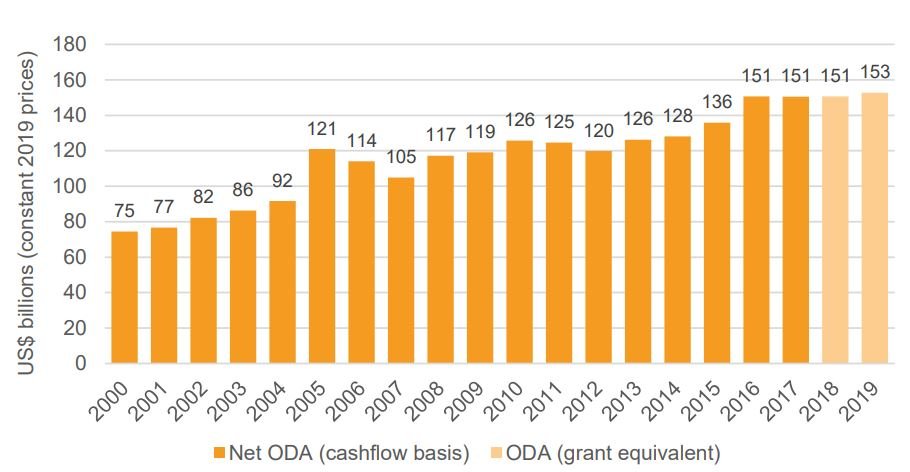
ODA increased in 2019 by 1.4% to reach US$152.8 billion
Source: Development Initiatives based on OECD DAC data
Note: The chart shows net ODA and grant equivalent ODA for the years in which they respectively represented headline ODA. The difference between the old (net ODA) and new (grant equivalent) measure is attributed to the way that ODA loans are accounted for; under the old measure the full face value of the loan is reported with loan repayments subtracted, while under the new measure only the grant equivalent of the loan is reported (and loan repayments are not subtracted).
- Using the grant equivalent ODA measure, total ODA increased by US$2.1 billion (or 1.4% in real terms) between 2018 and 2019. The 2019 level represents an alltime high of US$152.8 billion.
- Notable increases between 2018 and 2019 were recorded by Japan (US$1.1 billion), France (US$496 million) and the UK (US$413 million).
- Notable decreases between 2018 and 2019 were reported by Germany (US$338 million), Sweden, (US$274 million), the Netherlands (US$224 million) and the US (US$146 million).
Coronavirus
In the current crisis
- If coronavirus leads to economic recession in DAC donors this could cause a further significant fall in ODA.
The economic impact of coronavirus may lead to further substantial declines in ODA
Figure 2: Economic recession in donor countries may sharply reduce ODA levels, especially if donors reduce the share of national income spent on aid
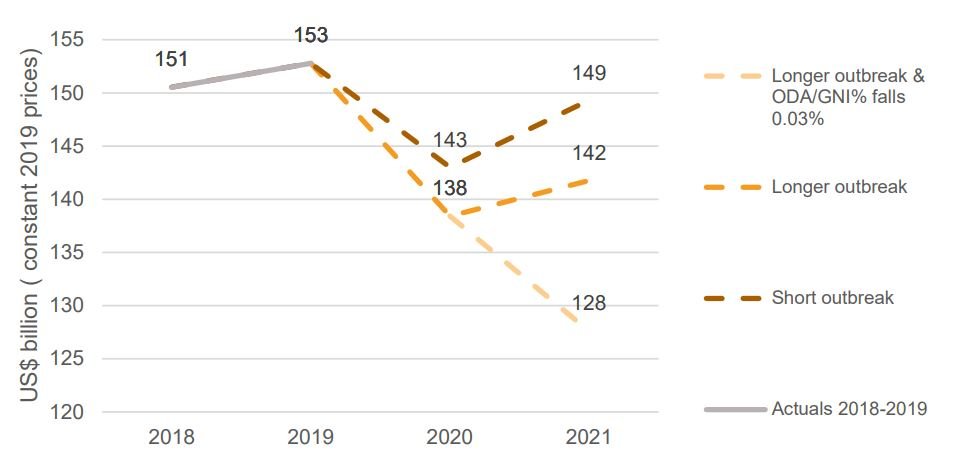
Economic recession in donor countries may sharply reduce ODA levels, especially if donors reduce the share of national income spent on aid
Source: Development Initiatives based on OECD DAC and IMF WEO data
- This chart models three different scenarios, based on the latest growth predictions for donor economies published by the International Monetary Fund (IMF) on 14 April 2020. [5]
- The IMF’s baseline assumption is for a deep, but short-lived recession, where the pandemic fades and economic activity starts to pick up in the second half of 2020. Under this scenario, ODA could fall by almost US$10 billion to US$143 billion in 2020 before recovering to US$149 billion in 2021, (assuming donors continue to give the same percentage of their GNI as ODA).
- A deeper downturn caused by the pandemic and its associated economic impact (persisting until early 2021) is predicted to reduce growth by an additional 3% in 2020 and 2% in 2021. [6] Under this scenario, ODA could fall by US$14.4 billion to US$138 billion, recovering slightly to US$142 billion in 2021. Again, this assumes donors continue to give the same percentage of their GNI as ODA.
- A third scenario shows the impact if the prolonged downturn of the second scenario, coupled with the cost of fiscal stimulus measures in donor countries, causes donors to reduce their ODA/GNI ratios by 0.03% in 2021. Under this scenario, ODA would continue to fall sharply in 2021 to US$128 billion (US$25 billion below 2019 levels).
Coronavirus
In the current crisis
- Any reduction in ODA levels in the wake of the coronavirus pandemic would hit developing countries that are already suffering from multiple other negative effects of the crisis. Other global resource flows to developing countries are also set to fall substantially.
- Developing economies have experienced the highest level of capital flight on record, with investors withdrawing around US$90 billion from emerging economies in March 2020 alone. [7] Foreign direct investments (FDI) could fall by 30% to 40% in 2020. [8]
- Countries dependent on exports of commodities such as oil and minerals have been hit by steep falls in commodity prices. [9]
- The loss of tourism receipts for developing countries is, as yet, unquantified but likely to be significant and remittances are likely to fall as some of the largest remittance-sending countries have been hard-hit by the coronavirus pandemic.
- In 2017 remittances, FDI and tourism were the largest sources of international finance to LDCs – generating inflows of US$39 billion, US$28 billion and US$19 billion respectively. [10]
The number of donors achieving the 0.7% ODA/GNI target remains the same, but there is potential for all donors, including those hitting this target, to see these ratios fall
- In 2019, the same five donors achieved an ODA/GNI level of 0.7% or higher as in 2018 (Luxembourg, Norway, Sweden, Denmark and the UK). There were no other donors joining or leaving the ‘0.7% group’ between 2018 and 2019, or significant rises or falls recorded among other DAC donors.
- Both Norway and Luxembourg, already above the ODA/GNI 0.7% threshold, further increased their shares between 2018 and 2019; Norway from 0.94% to 1.02% and Luxembourg from 0.98% to 1.05%. Finland increased its ODA GNI share from 0.36% to 0.42%.
- Sweden's ODA/GNI % fell from 1.07% to 0.99% (still well above the 0.7% threshold). A significant driver in the fall of Sweden’s ODA to GNI share was a reduction in ODA to refugee hosting between 2018 and 2019, from US$496 million to US$267 million.
- The ODA/GNI % of the Netherlands fell from 0.62% to 0.59%.
Coronavirus
In the current crisis
- A reduction in donors’ ODA as a percent of their GNI (resulting from domestic coronavirus spending) may cause significant decreases in their ODA by 2021.
- Under the scenario of a longer-lasting coronavirus outbreak (in which growth is 3% below the IMF baseline in 2020, 2% below it in 2021 and donors reduce their 2019 ODA GNI ratio by 0.03% in 2021) levels of ODA from the US would fall by an estimated US$8.2 billion between 2019 and 2021 – almost a quarter.
- Under the same scenario, the UK, Denmark and Sweden (all currently reaching the 0.7% ODA/GNI target) would record notable falls in aid. ODA from the UK would fall by US$2.2 billion between 2019 and 2021 (12%), ODA from Sweden would fall by US$526 million (10%) and ODA from Denmark would fall by US$251 million (10%).
ODA to the most vulnerable countries grows slightly, ahead of potential real-terms cuts
Figure 4: ODA to least developed countries remains below its 2011 peak
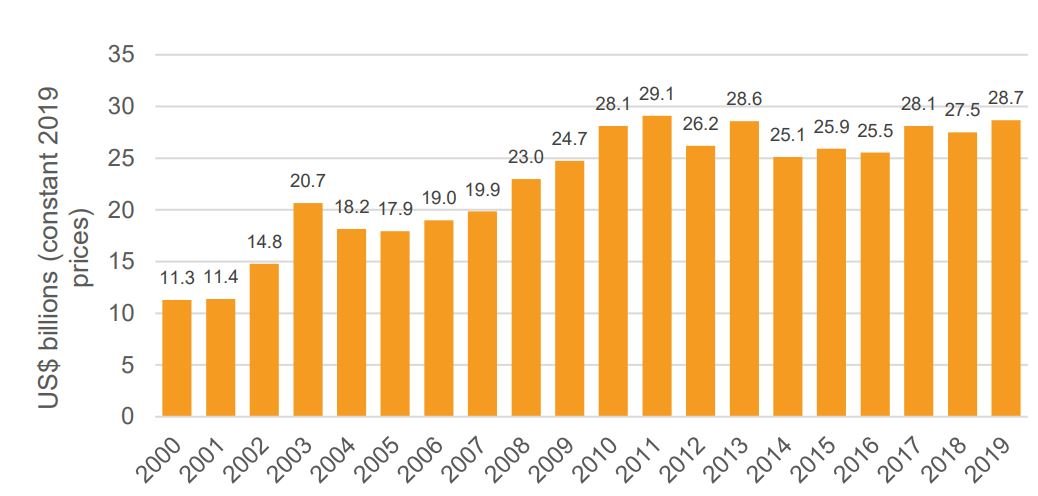
ODA to least developed countries remains below its 2011 peak
Source: Development Initiatives based on OECD DAC data
Notes: Data on ODA to LDCs is only available on a net ODA basis. Germany and Luxembourg failed to report how much of their ODA went to LDCs in 2019; so, in the absence of complete data, this chart assumes that Germany and Luxembourg gave the same proportion of support to LDCs in 2019 as they did in 2018 and applies this proportion to their 2019 net ODA levels.
- ODA to LDCs is estimated to have increased between 2018 and 2019 by 4.2% (or US$1.2 billion) to reach US$28.7 billion. Levels in 2019 remained lower than the peak year 2011 (US$29.1 billion).
- At the donor level, notable increases in ODA to LDCs included the US (an increase of US$821 million) and the UK (an increase of US$359 million). In total, eight donors are estimated to give over 30% of their bilateral ODA to LDCs: Belgium, Iceland, Ireland, Korea, Luxembourg, Portugal, Sweden and the US.
- Growth over the last decade in ODA to LDCs compares unfavourably to levels of growth in other middle-income countries. Between 2011 and 2019, net ODA to LDCs from DAC donors fell by 1.5%, while between 2010 and 2018, net ODA to non-LDC middle-income countries increased by 7.6%.
Coronavirus
In the current crisis
- The health systems of LDCs are at particular risk of being overwhelmed in the face of a significant outbreak of coronavirus. While the US has 34.7 intensive care beds with ventilators per 100,000 people; Uganda has only 0.1. There are reports that Liberia may have no more than a few. [11]
- Domestic general government health expenditure per capita in 2017 was PPP$29 in LDCs; 10 times lower than the level in non-LDC developing countries (PPP$315) and 100 times lower compared to high-income countries (PPP$3,692). [12]
Gross ODA lending by DAC donors up by 50% since 2010, despite warnings of a new debt crisis – and the growth has been fastest in lending to least developed countries
- Loans, as a component of ODA, have risen rapidly in recent years and bilateral lending from DAC donors reached a new peak in 2019 at US$19.5 billion.
- The vast majority of bilateral lending is carried out by a handful of DAC members, with Japan, France and Germany collectively accounting for 92% of new gross lending in 2019.
- Bilateral ODA loans grew by almost 50% between 2010 and 2018, while grants grew by just 13% over the same period.
- The shift from grants to loans is most pronounced in the poorest countries. In LDCs, bilateral ODA loans grew by almost 400% between 2010 and 2018, while grants were cut by 10%.
- Lending from multilaterals has also grown, by 84% across all developing countries and by 131% in LDCs. This has coincided with more core funding being given to loan-giving multilateral bodies (see Figure 6).
Coronavirus
In the current crisis
- This rapid rise in lending comes against a backdrop of increased warnings of a potential new debt crisis in developing countries. In 2015, 16 low-income countries were assessed as being either at high risk of debt distress, or actually in debt distress. By the end of 2019 this had more than doubled to 33 countries. [13]
- The 17 countries that were added to the highest risk categories between 2015 and 2019 received over US$16 billion in new ODA loans between 2015 and 2018 (data for 2019 is not yet available). Of this, US$13.4 billion was from multilateral lenders and US$2.4 billion from DAC members.
- In 2019, 64 developing countries spent more on debt service than on health; in 19 of these countries the cost of debt service was more than a fifth of government revenue. [14]
- Countries struggling to repay their debts will face increased constraints on their ability to respond financially to the economic effect of the pandemic.
Despite a rise in 2019, core contributions to the UN flatlined for most of the decade and lagged behind funding for loan-giving bodies
- Overall core funding of multilateral bodies by DAC donors rose by 20% between 2010 and 2019.
- The amount of multilateral ODA has remained almost unchanged in the last four years.
- DAC donors give an average of 28% of their ODA in the form of core funding to multilateral bodies; however, the US gives the smallest proportion of multilateral ODA – accounting for just 12% of its ODA in 2019.
- Core funding to the World Bank peaked at over US$11 billion in 2018, before falling back to US$9.6 billion in 2019. Over the course of the decade the World Bank received 44% more core funding than the UN.
- Core funding to regional development banks increased by almost 40%.
- Funding to some vertical funds has risen significantly. For example, funding to Gavi (the vaccine alliance) rose by 111% between 2010 and 2018 (2019 data is not yet available).
- Core contributions to UN remained largely static throughout the decade, rising by almost US$0.6 billion in 2019 to stand at US$7 billion – 15% higher than in 2010.
Coronavirus
In the current crisis
- The World Health Organization has a key role to play in the current crisis, yet assessed core contributions to it fell by 13% between 2011 and 2018.
Following substantial growth in bilateral humanitarian assistance since 2012, such funding has fallen year on year since 2017 while needs have continued to rise
Figure 7: Following strong growth since 2012, humanitarian ODA from DAC donors has fallen year on year since 2017
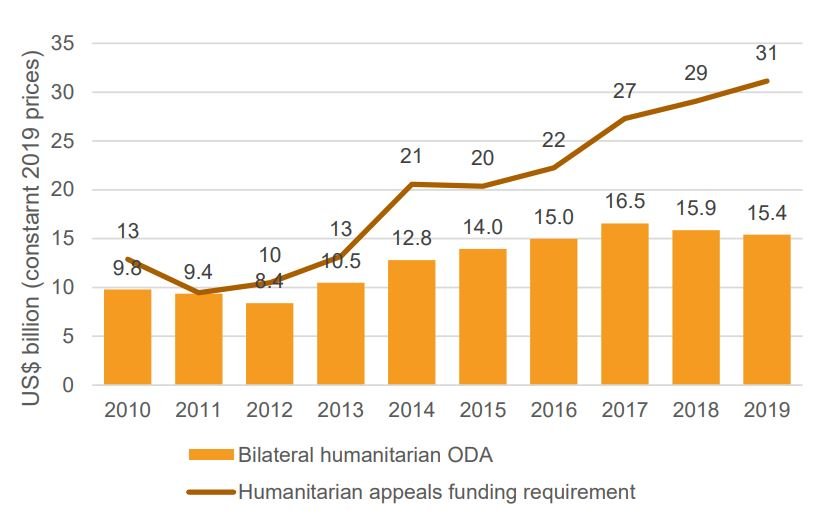
Following strong growth since 2012, humanitarian ODA from DAC donors has fallen year on year since 2017
Source: Development Initiatives based on data from the OECD DAC, UN OCHA’s Financial Tracking Service, UNHCR
Note: It is not visible from DAC data what portion of official humanitarian assistance goes to UN appeals, which serve as proxy for funding need of the global humanitarian response.
- Humanitarian aid almost doubled between 2012 and 2017, growing significantly faster than development aid over the period.
- However, humanitarian aid from DAC members has fallen year on year since 2017, down to US$15.4 billion in 2019.
- Conversely, funding requirements to respond to crises has continued to rise, resulting in more than a third of the volume of UN humanitarian appeals unmet – a funding gap that has persisted over the last decade.
Coronavirus
In the current crisis
- The coronavirus pandemic will exacerbate the trend of year-on-year increases in humanitarian need. The UN has launched a US$2 billion coordinated global humanitarian response plan to mitigate the direct impact of coronavirus in some of the most vulnerable countries. At time of writing, 25% of this funding requirement had been met.
- The extent to which donors respond to this through newly available funding is unknown. A repurposing of existing humanitarian and wider aid resources risks widening the funding gap further for existing crises and other contexts.
Notes
-
1
See this slide deck precis of the 2020 Financing for Sustainable Development Report by the Inter-agency Task Force on Financing for Development, available at: https://developmentfinance.un.org/sites/developmentfinance.un.org/files/FSDR%202020%20slides_0.pdf . The full report is available here: https://developmentfinance.un.org/fsdr2020Return to source text
-
2
See this slide deck precis of the 2020 Financing for Sustainable Development Report by the Inter-agency Task Force on Financing for Development, available at: https://developmentfinance.un.org/sites/developmentfinance.un.org/files/FSDR%202020%20slides_0.pdf . The full report is available here: https://developmentfinance.un.org/fsdr2020Return to source text
-
3
United Nations University, Widner, Will COVID-19 lead to half a billion more people living in poverty in developing countries? Available at: www.wider.unu.edu/publication/will-covid-19-lead-half-billion-more-people-living-poverty-developing-countriesReturn to source text
-
4
Economic Commission for Africa, COVID-19 in Africa: Protecting Lives and Economies. Available at: www.tralac.org/documents/resources/covid-19/3293-covid-19-protecting-african-lives-and-economies-uneca-april-2020/file.htmlReturn to source text
-
5
International Monetary Fund, World Economic Outlook Database, April 2020. Available at: www.imf.org/external/pubs/ft/weo/2020/01/weodata/index.aspxReturn to source text
Related content
How is aid changing in the Covid-19 pandemic?
This briefing sets out near real-time data on aid for the first half of 2020. It shows how commitments are changing in the Covid-19 pandemic and where these are most likely to affect the poorest people and places.
How is Covid impacting people living in poverty worldwide?
Use interactive charts and analysis of key trends to explore how the Covid-19 pandemic is affecting people living in poverty at the global, regional and national levels, as well as inequality within countries. What makes certain groups vulnerable to its impacts?
ODA (aid) spending in 2018
DI presents analysis of the final ODA (aid) data for 2018. Our factsheet shows how much was given and in what form, as well as a breakdown of recipient countries and sectors, and the share of aid going to projects focused on climate or gender.
